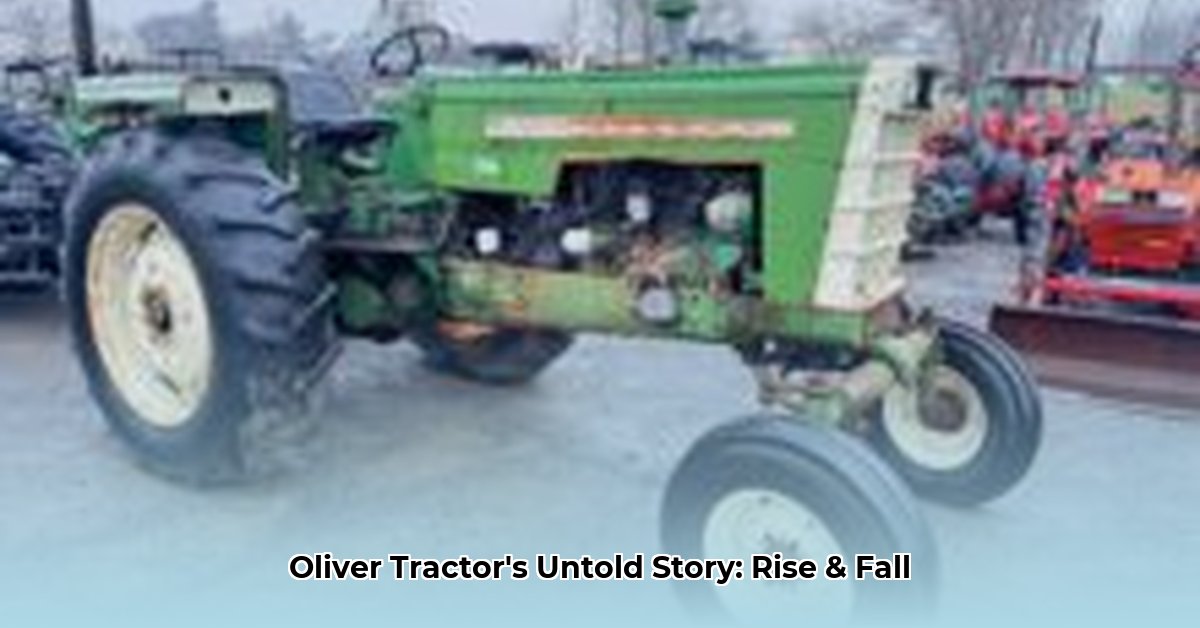
Oliver Tractor PN: A Story of Steel, Innovation, and Enduring Legacy
The Oliver Farm Equipment Company, formed in 1929 through a merger, quickly became a dominant force in American agriculture. Their tractors, renowned for their robust construction and dependable performance, became ubiquitous across the nation's fields. Early models, such as the Oliver 18-28, relied on gasoline engines, but Oliver’s commitment to innovation led to the adoption of more powerful diesel engines in later models like the 2255. This continuous improvement strategy fueled their success for a considerable period. However, even the most successful enterprises face challenges, as the Oliver story demonstrates. For more on tractor history, see this Case Tractor History.
Technological Advancements in Oliver Tractors
Oliver tractors were not merely powerful machines; they exemplified cutting-edge technology. The company invested heavily in research and development, continually refining its engine designs. While precise horsepower figures for some models remain elusive due to incomplete historical records, the overall trajectory of improvement is undeniable. The evolution from smaller gasoline engines to larger, more efficient diesel powerplants showcases the company's dedication to technological advancement. This commitment to innovation significantly shaped their success within the highly competitive agricultural machinery market.
The Impact of the White Motor Corporation Merger
The acquisition of Oliver by the White Motor Corporation marked a turning point. While mergers are often portrayed as beneficial, in this instance, it proved detrimental to the Oliver brand. The eventual cessation of Oliver tractor production in 1973, including the Oliver PN, is largely attributed to White Motor Corporation prioritizing its own brand, effectively overshadowing Oliver's legacy. This serves as a cautionary tale regarding the potential risks associated with large corporate takeovers and the challenges faced by smaller players in fiercely competitive industries. Did the merger ultimately stifle innovation at Oliver? The evidence suggests it did.
The Enduring Appeal of Oliver Tractors
Despite their disappearance from factory assembly lines, Oliver tractors maintain a significant following. Collectors and enthusiasts actively seek these vintage machines, captivated by their robust construction and rich history. Many Oliver tractor PN models undergo meticulous restoration, transforming them into prized possessions for their owners. The existence of dedicated online communities and clubs further underscores the lasting appeal of these machines, showcasing the quality and enduring charm that continues to resonate with countless individuals. This enduring popularity speaks to Oliver's lasting contribution to agricultural history.
Oliver's Lasting Impact on Farming Practices
Oliver's contribution to agricultural technology is undeniable. Their tractors revolutionized farming practices for decades. Their story provides valuable lessons, not only for those in agricultural engineering but also for anyone interested in business strategy and innovation. The study of Oliver's history offers critical insights into the evolution of farm equipment and the complex challenges faced by companies within this industry. Analyzing their rise and fall offers a valuable case study in business strategies. What factors ultimately contributed to their decline? The available evidence points to a combination of factors, including the White Motor Corporation merger and the overall competitive landscape.
Preserving the Oliver Legacy
Preserving Oliver’s legacy necessitates a concerted effort. Collectors must meticulously document available information about their tractors, filling gaps in historical records, especially concerning horsepower specifications for various Oliver PN models. Agricultural historians need to examine the impact of mergers and acquisitions on innovation within the industry. Furthermore, museums should actively collect and display Oliver tractors to educate future generations about their crucial role in shaping modern agriculture. It's vital to ensure that the history of these important machines is not lost to time.
Finding Missing Horsepower Data for Vintage Oliver Tractors: A Guide
Key Takeaways:
- Oliver tractor horsepower data can vary widely across different sources, hindering consistency.
- Original factory specifications are the most dependable source for accurate horsepower figures.
- Nebraska Tractor Test results, when available, provide valuable performance data.
- Online forums and collector communities are invaluable resources for historical data.
- Careful cross-referencing of multiple sources is essential for validating data accuracy.
Accessing complete and accurate data on horsepower for certain Oliver PN models presents a significant challenge due to incomplete historical records and variations in testing methods.
Locating Historical Power Output Information
The most dependable source of horsepower data for Oliver tractors is original factory documentation, including service manuals. However, the scarcity of these documents necessitates exploring alternative avenues. Reliable secondary sources include:
- Nebraska Tractor Tests: These independent tests, performed on numerous tractors from the era, provide valuable horsepower measurements.
- Online Tractor Databases: Websites such as TractorData.com offer compiled information, though accuracy should be verified through cross-referencing.
- Online Forums and Communities: Engaging with knowledgeable enthusiasts within online communities can provide access to unique information and insights.
Addressing Data Discrepancies
Variations in reported horsepower stem from several factors: manufacturing tolerances, variations in testing methodologies, post-production modifications by owners, and even differing regional standards. By implementing a strategy of cross-referencing alongside careful analysis, the most accurate power output figures are more likely to be achieved.
The Broader Narrative: Beyond Horsepower
While horsepower is a crucial element, it only encapsulates one facet of the Oliver tractor story. The impact of Oliver tractors extended far beyond their power output. Their evolution in design directly impacted farming methods, demonstrating a broader shift in agricultural techniques. The overall story of Oliver highlights the impact that decisions regarding innovation, company strategy and market dynamics have.
Conclusion: A Continuing Legacy
Researchers must maintain persistence in their efforts to uncover and verify data about the Oliver tractor. By utilizing a variety of resources and carefully cross-referencing findings, a more comprehensive understanding of their history and capabilities can be achieved. This dedication is crucial for preserving the legacy of Oliver’s contribution to agricultural advancement.